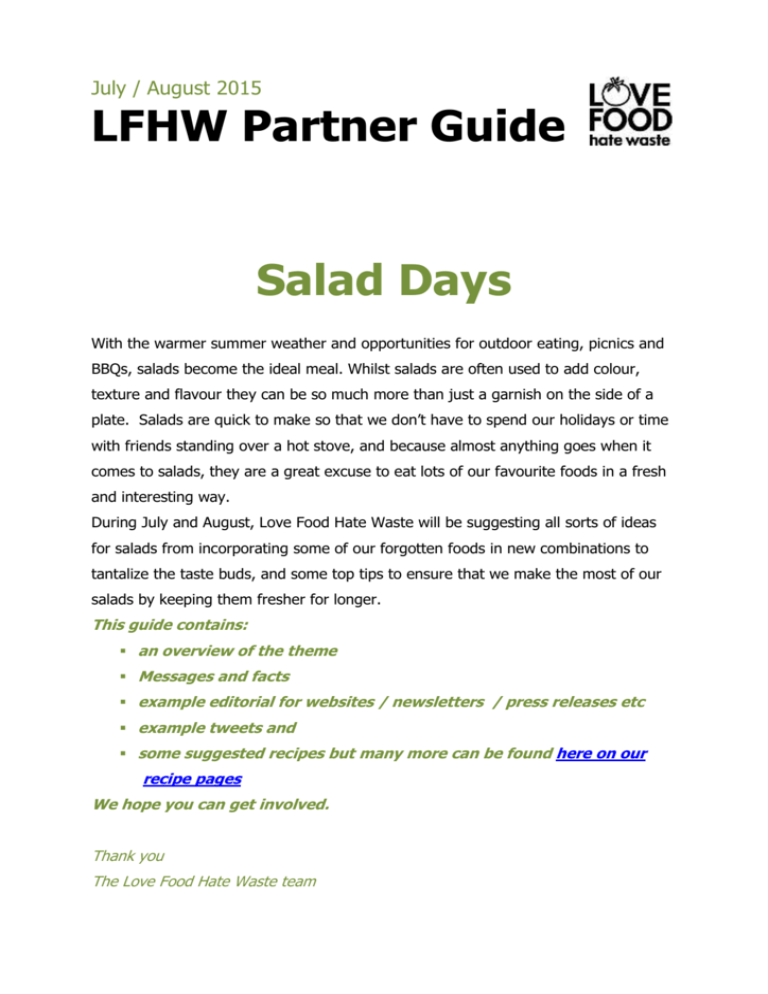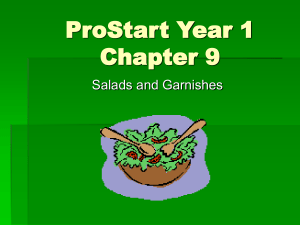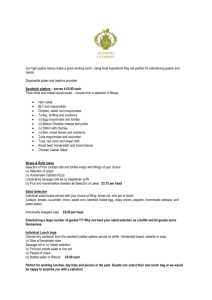UK Partner Guide: Salad Days
advertisement

July / August 2015 LFHW Partner Guide Salad Days With the warmer summer weather and opportunities for outdoor eating, picnics and BBQs, salads become the ideal meal. Whilst salads are often used to add colour, texture and flavour they can be so much more than just a garnish on the side of a plate. Salads are quick to make so that we don’t have to spend our holidays or time with friends standing over a hot stove, and because almost anything goes when it comes to salads, they are a great excuse to eat lots of our favourite foods in a fresh and interesting way. During July and August, Love Food Hate Waste will be suggesting all sorts of ideas for salads from incorporating some of our forgotten foods in new combinations to tantalize the taste buds, and some top tips to ensure that we make the most of our salads by keeping them fresher for longer. This guide contains: an overview of the theme Messages and facts example editorial for websites / newsletters / press releases etc example tweets and some suggested recipes but many more can be found here on our recipe pages We hope you can get involved. Thank you The Love Food Hate Waste team Overview Even those of us who are convinced that we don’t waste much food will admit to discarding salad items. In fact avoidable fruit, vegetable and salad waste thrown away from UK homes comes to an eye watering 1.2 million tonnes each year, worth a pocket watering £2.6billion1. The most common reason given for throwing away food is because it was not used in time2. This is the case for foods that could be used in salads including onions, apples, potatoes and carrots3. Almost half of the 1 million tonnes of food and drink waste that is thrown away whole or unopened is fresh vegetables and salads4. Love Food Hate Waste will be providing ideas and recipes on how this food can be used before it goes off. Salads are so much more than just fruit and veg. Famous signature salads such as Caesar, Waldorf or Nicoise and those from across the world use foods from all the main food groups - meats, fish, dairy, eggs and grains. Standard storecupboard items such as nuts or olives can be added in. The first Caesar salad is believed to have been made out of leftovers when the restaurant supplies were running low so we are in good company if we experiment and at the same time turn small amounts of forgotten foods and leftovers into something spectacular. Mixtures of small portions of leftovers that can often be ignored because they don’t make much of a meal by themselves make a varied and interesting addition to a basic salad. Just a rasher of crispy bacon or a slice of ham, a crunchy apple, a few slices of pepper, a portion of rice or boiled potatoes, some cubes of cheese or a 1 Based on WRAP’s Household Food and Drink Waste in the UK 2012 Based on WRAP’s Household Food and Drink Waste in the UK 2012 3 Based on WRAP’s Household Food and Drink Waste: A product Focus 2014 4 Based on WRAP’s Household Food and Drink Waste: A product Focus 2014 2 handful of toasted nuts or seeds added to some basic salad leaves and a spectacular salad starts to emerge. Storing our foods correctly ensures that they stay fresher for longer, giving us more time to ensure that we use them up before they go off. While most of us would always store salad leaves in the fridge, salad staples such as onions, carrots, peppers and apples will also last a lot longer if they are put in the fridge and left in their original packaging. Salad dressings bring together all those lovely flavours and give us an opportunity to use some of those foods that can sometimes languish in the cupboard, or sit in the fridge door. We waste 140,000 tonnes of condiments, sauces, herbs and spices every year5, but many of these can be put to good use to make a delicious dressing to add the final flourish to your salad. Don’t forget – there’s a wide range of FREE materials that you can download to help you promote this theme in your local area at www.lovefoodhatewaste.com/partners Other things happening at this time Wimbledon 29th June – 12th July Eid-ul-Fitr 17th July School Holidays Summer Bank Holiday 31st August Messages and facts 5 Salads are so much more than a bit of garnish. They are an easy and quick way to create lovely meals that incorporate all sorts of leftovers and forgotten foods. Salads, fresh fruits and vegetables make up the largest proportion of avoidable food waste in the UK – 1.2 million tonnes worth £2.6 billion are thrown out from UK households each year. Almost half of the 1 million tonnes of food and drink waste that is thrown away whole or unopened is fresh vegetables and salads Based on WRAP’s Household Food and Drink Waste in the UK 2012 The most common reason for this waste is that the foods are not used in time so by storing foods correctly they can remain fresher for longer. Households can save money by making the most of these foods before they go off. Salad staples such as leaves, onions, carrots, peppers, oranges and apples should be stored in the fridge in their original packaging. Salads are a perfect way to serve all sorts of small portions of favourite leftovers and forgotten foods from all the main food groups including fish, meat, dairy eggs and grains. Storecupboard standards such as nuts, seeds, dried fruit or tinned fish can be added to salads. Condiments and salad dressings can easily languish in the fridge door – checking the dates and knowing when they have been opened will help to ensure that they are used in time. What can you do to get involved? Big actions, big impact Use our ready-made editorial available at wwwlovefoodhatewaste.com/partners to generate press coverage in your local media. Get the local radio stations to link to the theme. Try an on-air “salad days” session where listeners share ideas for the perfect picnic or BBQ salad. It can be a quiet time for local papers. Instead of silly season, encourage them to make it salad season. Many like ready-made stories so encourage them to use the partner material. Seize-a-Salad. Caesar salad was thought to have been invented out of leftovers. Hold a competition for residents and customers to come up with their ideas for transforming leftovers into a spectacular summer salad. Suggest to local media that the partner materials have some ideal tips to help people save money that could then be spent on holidays or summer days out. If they are not interested in a food feature, suggest a family finance feature instead. Send information to residents and colleagues put a link to Love Food Hate Waste on your website. For retailers and brands: Feature those foods that can easily be incorporated into salads. Suggest recipes for salads and dressings to go with them to help inspire super tasting salads. Make a feature of those things that help keep salads fresh and crisp – lidded containers, clips, bags or even lovely bowls and salad servers to set the food off. Suggest recipes and storage tips for the larger multi packs of veg, fruit and salad so that less is wasted. Why not make use of our free template materials? The time-saving tips and ideas are perfect for those who want to make the most of their holidays or days out rather than spending hours in the kitchen. Add information to your customer and colleague communications – magazines, e-zines, POS recipes in the appropriate section, website, social media, blogs etc. Small actions, big impact If you do nothing else… Add the LFHW editorial information to your website Make a feature of the LFHW information about keeping food fresher for longer. Put out our template tweets on your Twitter feed Make use of the Love Food Hate Waste videos – you can embed any of these on your own website free of chargeespecially the following – Fresher for longer, Savvy Storage, Fruit and Veg and Storage with Sallie Encourage people to sign up to the Love Food Hate Waste newsletter which will have a Salad Days theme. Blog about using leftovers and forgotten foods in salads – you could use our template editorial as a starting point. Link your website to lovefoodhatewaste.com ‘Like’ us on Facebook Follow us on Twitter What are we doing? We’ll be working with the media (particularly regional broadcast/print and lifestyle) and our partners to promote our information and solutions for helping consumers make the most of salads foods and how they can use leftovers and forgotten foods to make Our social media activity on Twitter and Facebook will ramp up and focus on this theme during July and August. We’ll be looking to engage new partners to help us promote the theme, using our template editorial, recipes and tweets Our regular blog will focus on Salad Days July and August. Resources on the Love Food Hate Waste and partners’ site Template editorial Twitter ideas Recipes LFHW posters/adverts/leaflets LFHW videos LFHW App All available on the LFHW partner website at: www.lovefoodhatewaste.com/partners Videos available to use LFHW has lots of free videos available for you to use – from menu planning, perfect portions, savvy storage to making perfect roast potatoes. There are plenty to choose from! To share the videos simply follow the link above, click on the video that you want to share and then hover the cursor over the right hand side of the video frame – the “share” icon will appear – click on it and then choose the “copy URL” option to get the link to paste elsewhere. If you would like to embed one of the videos on your own website, follow the instructions above, but instead of choosing the “Share” icon choose the “Embed” icon – you can then copy the embed code required to add the video to your website. Editorial This is example content which you can use for newsletters, websites, articles, blogs and turning into a press release – mix and match to make it work for you and your audience. Salad Days Why let over 1 million tonnes go to waste? Enjoy your salad days and save money too! Salads can be the stars of summer eating. With the warmer weather and outdoor eating, picnics and BBQs, salads become the ideal meal. Salads are quick to make so that we don’t have to spend our holidays or time with friends standing over a hot stove, and because almost anything goes when it comes to salads, they are a great excuse to eat lots of our favourite foods in a fresh and interesting way. They are also a clever way to re-invent those leftovers and forgotten foods that would otherwise not be used in time, saving us all money that could be spent on summer fun instead. Turn over a new leaf Sadly salads, fresh fruit and veg are some of our most wasted foods with an eye watering 1.2 million tonnes worth a pocket watering £2.6 billion each year being chucked away from UK homes6. Almost half of the 1 million tonnes of food and drink waste that is thrown away whole or unopened is fresh veg and salads7. Despite our best intentions to eat the salad we have bought, the most common reason for this waste is that the food just wasn’t eaten in time. We often forget we have it in, run out of inspiration and or even get a bit bored with what we have in the fridge. Love Food Hate Waste is here to help with some easy tips, ideas and recipes to tantalize your taste buds by turning those Cinderella salad staples into the belles of the ball. 6 7 Based on WRAP’s Household Food and Drink Waste in the UK 2012 Based on WRAP’s Household Food and Drink Waste: A product Focus 2014 So much more than a bit on the side Salads are much more exciting than just a leafy garnish on the side of a plate! In fact, salads can be the quickest, easiest and tastiest way to use up some of our forgotten foods. The good news is that it often only takes a short time to put together small portions of leftovers, a couple of things from the fridge, fruit bowl or store cupboard in new combinations to create your own signature summer salad. Pretty much anything goes as salads become a perfect excuse to eat as many of your favourite foods in one dish. Small Potatoes? Take a helping of cooked, cold potatoes – add a dollop of mayo and then rummage around to find other things to add in. How about a crisp apple for crunch, a chopped onion for punch, a stick of celery, a spoonful of chopped nuts and what was a rather unappealing portion of leftover spuds is starting to transform into something much more interesting. Just a slice of ham or sausage, a helping of leftover cold meats, a sliced boiled egg, cubes of cheese – these are the sorts of forgotten foods that we end up ignoring because they don’t make a meal in themselves – but combined into a salad and they become a speedy meal solution. Why not make life easy by going with the grain? Leftover rice, pasta, couscous and bulgur wheat are all great starting points for a salad. Grate together Large amounts of foods that are binned each year could have been eaten including 73,000 tonnes of fresh carrots and 55,000 tonnes of onion – ideal ingredients for homemade coleslaw. Grated cabbage, celeriac, dried and fresh fruits can be added in – and the great thing about homemade coleslaw is that you can choose just how chunky you want it to be. Leftover dips or natural yoghurt can be added to or used as an alternative to mayo. Fruit and cheeses also work well together. Think about combining apple and cheddar, pear and blue cheese, brie and grape, mango with goat’s cheese – a useful way to reinvent the titbits from the cheeseboard. All Dressed Up and Ready to Go Cinderella Salads need to be well dressed and salad dressings bring together all those lovely flavours and give us an opportunity to use some of those foods that can sometimes languish in the cupboard, or sit in the fridge door. We waste 140,000 tonnes of condiments, sauces, herbs and spices every year8, but many of these can be put to good use to make a delicious dressing to add the final flourish to your salad. Is your fridge door all a-jar? You are not alone if you have a fridge door full of opened jars of dressings, sauces and pastes. The trouble is, it’s hard to remember when they were opened so how to tell if it’s still safe to eat? A top tip is to use a marker pen to write on the label when it was opened so that you know how long you have to finish it up. Take a look at our recipe for simple salad dressing – it can be frozen in small portions. Increased Mega bytes Salad doesn’t have to be all soft sappy stuff. To add a bit of crunch, try our quick recipe for making croutons out of unwanted crusts. For added flavour why not experiment with other types of bread that might otherwise be heading for the bin – garlic bread, naan or take a look at our recipe for Fatoush for ideas for pitta bread and salad. Fresher for longer The most common reason given for throwing away food is because it was not used in time9. So here are some of our top tips for keeping salads in tip top condition Salad leaves can bruise easily, so when shopping, try not to crush them in the bottom of the shopping trolley 8 9 Based on WRAP’s Household Food and Drink Waste in the UK 2012 Based on WRAP’s Household Food and Drink Waste in the UK 2012 Onions, carrots, peppers, oranges and apples will last a lot longer if they are put in the fridge and left in their original packaging. Leaves can be refreshed by popping them into iced water for 30 minutes. Celery, carrots and cucumber put in a glass of cold water in the fridge overnight will also revive. Tired spinach, watercress and lettuce leaves can be made into soup. Try our recipe for delicious and creamy limp lettuce soup. For hints, tips and recipes on how to make the best of the food that we buy and save up to £60 a month, visit lovefoodhatewaste.com. Salad Days Twitter ideas! If you use Twitter to share Love Food Hate Waste messages, here are some ideas for our Salad Days theme in July and August 2015. Why not try working with local community groups, find them on Twitter and give them an @ mention as part of the tweet. Hopefully they’ll retweet for all their followers to see! 1. Salad is so much more than just a bit on the side! Need ideas? Try the @LFHW_UK recipe finder http://bit.ly/1bqV9tC 2. All sorts of forgotten foods & leftovers turn a simple salad into a real meal deal. To save up to £60 a month visit http://bit.ly/Jj7Xga 3. Lovely salads don’t have to be expensive. In fact by wasting less food the average saving is up to £200 per year http://bit.ly/Jj7Xga 4. Save time and money by combining food from the cupboard, fridge and fruit bowl into interesting salads http://bit.ly/1bqV9tC 5. Try writing an ‘opened on’ date on salad dressing or mayo jars so you know how long you have to use them. More tips http://bit.ly/1l6z8bu 6. Keep it crunchy! Unwanted bread crusts make perfect homemade croutons and add bite to your salad. See recipe http://bit.ly/1rttdxN 7. From the Middle East to South America – get international inspiration for salads. Search our salad section http://bit.ly/1bqV9tC 8. Food not used in time? Keep your salad favourites fresher for longer. Save money with @LFHW_UK with these tips http://bit.ly/1i2WUUj There are plenty of hints and tips on the website which we find go down very well on Twitter – please feel free to tweet them. Be sure to include @LFHW_UK in your tweet so we can help retweet them as well. Suggested recipes limp lettuce soup - Lettuce that has gone limp can still be put to use, and it is magically transformed in this rich, sophisticated soup. recipe for making croutons - A salad becomes a satisfying meal with topped with crunchy croutons Fatoush - This traditional middle-Eastern salad is a perfect way to use up day-old pitta breads and makes a substantial but healthy lunch. Mixed vegetable mayo salad - Vegetable mayonnaise salads are extremely popular in South America, and are a great way to use up the left-over cooked vegetables from a big Sunday dinner Griddled green bean salad - This warm salad features added protein from boiled eggs. Garlic baked trout with avocado salad - Packed full of flavour and with plenty of vitamins and minerals, this baked trout is a versatile main dish. Serve it as soon as the trout comes out of the oven and dress the salad just before serving.



